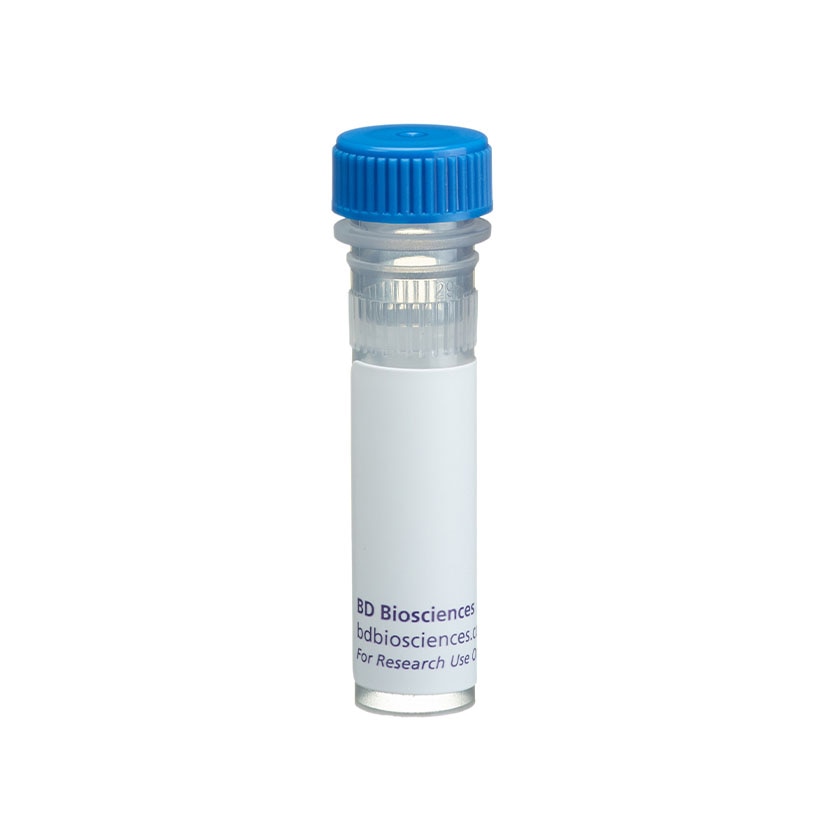Old Browser
Looks like you're visiting us from {countryName}.
Would you like to stay on the current country site or be switched to your country?







Western blot analysis of NF-κB p65 (pS529) in transformed human epithelioid carcinoma. Lysates from control (left panel) and TNF-treated (Cat. No. 554618, right panel) HeLa cell line were probed with purified mouse anti-NF-κB p65 (pS529) monoclonal antibody at concentrations of 0.0125, 0.00625 and 0.00312 µg/ml (Lanes 1, 2, and 3, respectively). NF-κB p65 (pS529) is identified as a band of 65 kDa, which is upregulated in the treated cells.


Western blot analysis of NF-κB p65 (pS529) in human peripheral blood mononuclear cells (PBMC). Lysates from control ((lane 1) and PMA-treated (lane 2) PBMC were probed with purified mouse anti-NF-κB p65 (pS529) monoclonal antibody at 2.0 µg/ml. NF-κB p65 (pS529) is identified as a band of 65 kDa in the treated cells.


BD Pharmingen™ Purified Mouse anti-NF-κB p65 (pS529)

BD Pharmingen™ Purified Mouse anti-NF-κB p65 (pS529)

BD Pharmingen™ Purified Mouse anti-NF-κB p65 (pS529)

Regulatory Status Legend
Any use of products other than the permitted use without the express written authorization of Becton, Dickinson and Company is strictly prohibited.
Preparation And Storage
Product Notices
- Please refer to www.bdbiosciences.com/us/s/resources for technical protocols.
- Caution: Sodium azide yields highly toxic hydrazoic acid under acidic conditions. Dilute azide compounds in running water before discarding to avoid accumulation of potentially explosive deposits in plumbing.
The K10-895.12.50 monoclonal antibody recognizes the phosphorylated serine 529 (pS529) in the transactivation domain of the human NF-κB p65 subunit. Nuclear factor κB (NF-κB) is a ubiquitously expressed transcription factor that regulates the expression of many other genes. It is crucial for cellular responses to a variety of stimuli including stress and microbial pathogens that lead to immunity, inflammation, proliferation, differentiation, survival, apoptosis, and tumorigenesis. The most studied NF-κB complex consists of the p50 (also known as NF-κB1) and p65 (also known as REL-A) subunits, both containing a 300-amino acid region with homology to the Rel proto-oncogene product (RH domain). The RH domain contains motifs for dimerization, nuclear localization, and binding to specific DNA sequences. In addition to the RH domain, the p65 subunit contains the transactivation domain, which is responsible for the interaction with the inhibitor IκB and which contains phosphorylation sites. In most cell types, the p50/p65 heterodimer is located within the cytoplasm complexed to IκB. This complex prevents nuclear translocation and activity of NF-κB. In response to stimuli such as cytokines, LPS, DNA damage, and microbial infections, IκB is phosphorylated at critical residues. This phosphorylation induces dissociation of the IκB/NF-κB complex, allowing the free heterodimeric NF-κB to translocate to the nucleus. Furthermore, optimal activation of NF-κB requires phosphorylation in the transactivation domain of p65. In the nucleus, activated NF-κB dimers bind to the κB sites within promoters and enhancers and function as transcriptional regulators.
Development References (3)
-
Natoli G, Saccani S, Bosisio D, Marazzi I. Interactions of NF-kappaB with chromatin: the art of being at the right place at the right time. Nat Immunol. 2005; 6(5):439-445. (Biology). View Reference
-
Siebenlist U, Brown K, Claudio E. Control of lymphocyte development by nuclear factor-kappaB. Nat Rev Immunol. 2005; 5:435-445. (Biology). View Reference
-
Viatour P, Merville M-P, Bours V, Chariot A. Phosphorylation of NF-kappaB and IkappaB proteins: implications in cancer and inflammation. Trends Biochem Sci. 2005; 30(1):43-52. (Biology). View Reference
Please refer to Support Documents for Quality Certificates
Global - Refer to manufacturer's instructions for use and related User Manuals and Technical data sheets before using this products as described
Comparisons, where applicable, are made against older BD Technology, manual methods or are general performance claims. Comparisons are not made against non-BD technologies, unless otherwise noted.
For Research Use Only. Not for use in diagnostic or therapeutic procedures.
Report a Site Issue
This form is intended to help us improve our website experience. For other support, please visit our Contact Us page.
